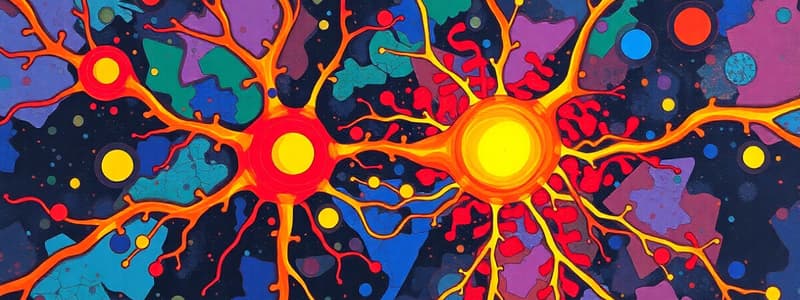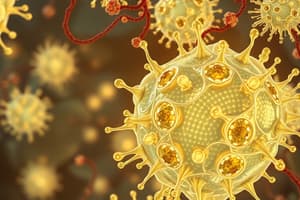Podcast
Questions and Answers
What is the initial effect of energy from the environment on sensory receptors?
What is the initial effect of energy from the environment on sensory receptors?
- No change in membrane potential
- Depolarization of the membrane (correct)
- Hyperpolarization of the membrane
- Inhibition of ion channel activity
What occurs when a receptor protein changes shape after receiving specific energy?
What occurs when a receptor protein changes shape after receiving specific energy?
- It only opens potassium channels
- It stops the transmission of nerve signals
- It modifies the membrane permeability (correct)
- It immediately generates an action potential
Which second messenger can be activated via G-protein coupling in sensory receptors?
Which second messenger can be activated via G-protein coupling in sensory receptors?
- Acetylcholine
- Cyclic AMP (cAMP) (correct)
- Serotonin
- Dopamine
What is the term for the change in membrane potential due to the reception of a sensory cue?
What is the term for the change in membrane potential due to the reception of a sensory cue?
In what way do photoreceptors differ from other sensory receptors in response to stimuli?
In what way do photoreceptors differ from other sensory receptors in response to stimuli?
What is the primary role of the receptor potential in sensory cells?
What is the primary role of the receptor potential in sensory cells?
Which type of adaptation is characterized by a receptor potential that is sustained for the duration of a stimulus?
Which type of adaptation is characterized by a receptor potential that is sustained for the duration of a stimulus?
How does habituation differ from adaptation in sensory response?
How does habituation differ from adaptation in sensory response?
What limits the impulse frequency in sensory systems after reaching a certain threshold?
What limits the impulse frequency in sensory systems after reaching a certain threshold?
What occurs when the intensity of a stimulus increases?
What occurs when the intensity of a stimulus increases?
What characterizes rapidly-adapting receptors?
What characterizes rapidly-adapting receptors?
What is a key function of exocytosis in sensory cells?
What is a key function of exocytosis in sensory cells?
During sensory transmission, where does the depolarizing current primarily travel to generate an action potential?
During sensory transmission, where does the depolarizing current primarily travel to generate an action potential?
In the context of sensory systems, what does the term 'coding of stimulus intensity' refer to?
In the context of sensory systems, what does the term 'coding of stimulus intensity' refer to?
What happens to the receptor potential if the stimulus remains constant over time?
What happens to the receptor potential if the stimulus remains constant over time?
What initiates the production of 2nd messengers in sensory cell transmission?
What initiates the production of 2nd messengers in sensory cell transmission?
Which best describes the role of G-protein in signal amplification?
Which best describes the role of G-protein in signal amplification?
How do olfactory receptors contribute to signal transmission?
How do olfactory receptors contribute to signal transmission?
What is the relationship between cAMP and ion channels in sensory cells?
What is the relationship between cAMP and ion channels in sensory cells?
What occurs at the trigger zone of a sensory cell?
What occurs at the trigger zone of a sensory cell?
What happens to the depolarizing current once it is generated?
What happens to the depolarizing current once it is generated?
How does the sensory cell release vesicles during signal transmission?
How does the sensory cell release vesicles during signal transmission?
Which stage of cAMP production amplifies the signal in sensory cells?
Which stage of cAMP production amplifies the signal in sensory cells?
Study Notes
Receptor Potential
- Change in membrane potential (MP) due to external sensory cues.
- Environmental energy interacts with membrane proteins, usually causing depolarization.
- Photoreceptors are an exception; they hyperpolarize.
- Receptor proteins in sensory cell membranes change shape upon receiving specific energy.
- Shape change either directly opens ion channels (e.g., cation channels leading to depolarization) or activates enzymes via G-protein coupling, producing second messengers (cAMP, cGMP, IP3) to amplify the signal.
- First patch of excitable membrane is usually at the branch point; receptor potential must travel and summate there to reach threshold for an action potential (AP).
Sensory Cell Transmission
- Sensory cells either generate an AP at a spike-generating zone or release vesicles when depolarized; impulses are then generated in the postsynaptic neuron.
Transmission of Signal (Vesicles)
- Depolarizing current doesn't produce APs; it travels to the other end of the membrane. Sufficient depolarization causes Ca++ influx and triggers vesicle exocytosis. The sensory cell releases vesicles without producing an AP. This is seen in taste receptors.
Transmission of Signal (AP)
- Occurs at the axon terminal (e.g., in sensory axons in the skin). Receptor potential travels to the branch point to summate and reach threshold for an AP.
Adaptation
- Membrane potential decays over time, even with a constant stimulus. This is known as adaptation.
- Slow Adaptation: Receptor potential sustained throughout the duration of the stimulus; concerned with overall stimulus magnitude.
- Rapid Adaptation: Receptor potential elicited by stimulus change; decays to zero with a constant stimulus; concerned with stimulus velocity.
Habituation
- Repeated identical stimuli elicit progressively weaker responses over time. The degree of habituation varies among cells.
Coding of Stimulus Intensity
- Receptor potential varies directly with stimulus intensity.
- Stronger stimuli cause greater receptor depolarization (graded potential), leading to more transmitter release and/or higher AP frequency.
- Greater depolarization speeds the membrane's recovery from hyperpolarization to generate new spikes.
- AP frequency is limited by the refractory period, leading to a ceiling effect for high intensity coding. Mechanisms for coding beyond the refractory limit are not described.
Coding of Modality
- There is no specific information provided on coding of modality (type of stimulus).
Receptive Field
- There is no specific information provided on receptive fields in this text.
Axon Reflex
- There is no specific information provided on axon reflex in this text.
Olfactory Receptor
- Specific receptor proteins bind specific odorants, activating G-proteins. This activates adenylyl cyclase, producing cAMP. cAMP binds to ion channels, allowing cation (Na+ and Ca++) influx and membrane depolarization. The depolarizing current travels to the axon's trigger zone. Signal amplification occurs.
Stages of Amplification (Olfactory Receptor)
- G-protein activates multiple enzyme molecules, each producing numerous cAMP molecules. This results in significant signal amplification from a single stimulus molecule.
Studying That Suits You
Use AI to generate personalized quizzes and flashcards to suit your learning preferences.
Related Documents
Description
Explore the processes involved in receptor potentials and sensory cell transmission through this quiz. Understand how environmental cues interact with membrane proteins to elicit changes in membrane potential. This quiz also delves into action potentials and the role of second messengers in amplifying signals.




